Analysis
Record-Breaking Basquiat Painting Leads Christie’s $318 Million Contemporary Sale
Bidding on the Basquiat opened at $24 million.
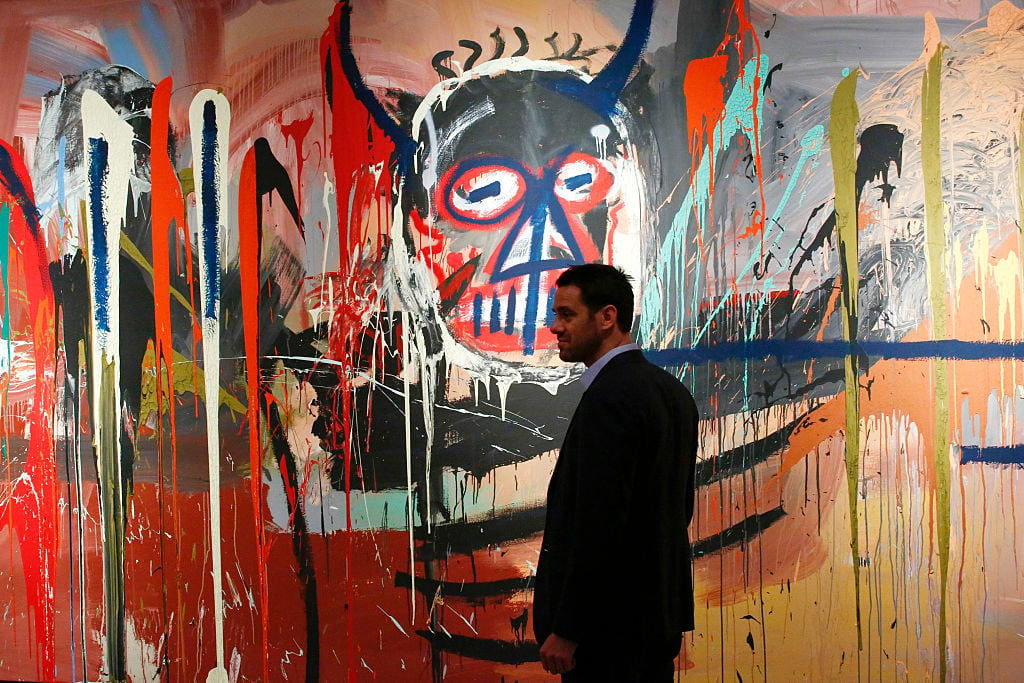
Bidding on the Basquiat opened at $24 million.

Eileen Kinsella

Christie’s major sale of postwar and contemporary art at Rockefeller Center in New York scored $318.4 million on Tuesday evening, near the low end of the presale estimate of $285.6 million to $398.2 million. Of 60 lots on offer (one was withdrawn), 52, or 87 percent, were sold.
Even considering the addition of Loic Gouzer’s $78 million hybrid “Bound to Fail” sale on May 8, totals to date—total current Christie’s sales of about $400 million—are a fraction of what they were last year.
In comparison, last year’s “Looking Forward to the Past” sale raked in $705.9 million, followed several nights later by a dedicated Christie’s postwar and contemporary sale that was not far behind, with $658.5 million. The two-sale total amounted to a mind-boggling $1.4 billion.
Which is not to say that Christie’s didn’t have its fair share of trophy artworks tonight; it just had far fewer of them.
The most expensive lot of the night was a large Untitled canvas by Jean-Michel Basquiat, dating from 1982. The late artist executed the work during a trip to Modena, Italy. It is part of a small group he made there that are considered to be among his most coveted works, along with Profit 1 and Boy and Dog in a Johnnypump.
The final price was $57.3 million, a new record for the artist at auction, compared with an unpublished estimate “in excess of $40 million,” according to Christie’s website. It marked a substantial increase on the previous record, of $48.8 million that was set for Dustheads, also made in 1982, that was sold at Christie’s New York in May 2013. Bidding opened at around $24 million and eventually narrowed to a $1 million-increment bidding war between international head of contemporary art Brett Gorvy, and head of client strategy for Christie’s in the Americas Koji Inoue, who were acting on behalf of their respective clients. The work was hammered down to Inoue’s client for $50 million.
In a sign of how far the market for Basquiat has come, Untitled last appeared at auction a dozen years ago, at Sotheby’s London in June 2004, where it sold for $4.5 million. (His previous auction record is $48.8 million, for Dustheads, which sold at Christie’s New York in May 2013.)
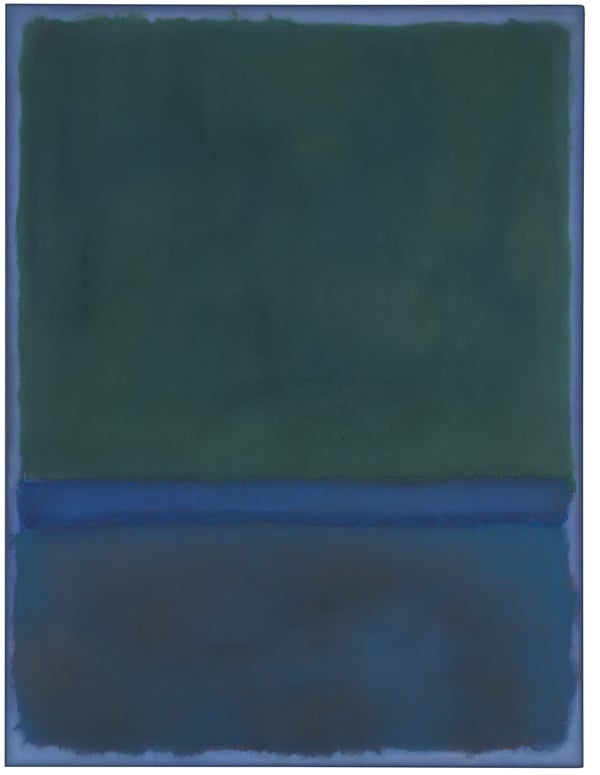
Mark Rothko No. 17 (1957). Courtesy of Christie’s Images Ltd.
Another trophy work, and the second-highest lot of the night, was Mark Rothko’s 1957 color field painting, No. 17.
The rare blue-toned work was estimated at $30–40 million. Though the painting had changed hands several times, including in a Sotheby’s private sale, this marked its first appearance at auction.
Though the final price was robust, it was lost on virtually no one paying close attention that bidding was restrained; auctioneer Jussi Pylkkanen seemed unwilling to accept that activity, which he opened at $24 million and talked up to $29 million, refused to budge, save for the exception of a single bid from postwar and contemporary art deputy chairman Barrett White.
Long past the point when it was clear there was no momentum—and no further bids—Pylkkanen kept turning to various specialists, addressing them by name, and inquiring whether there was interest. He finally hammered down the work to White’s anonymous bidder. With premium, the final price was $32.6 million.
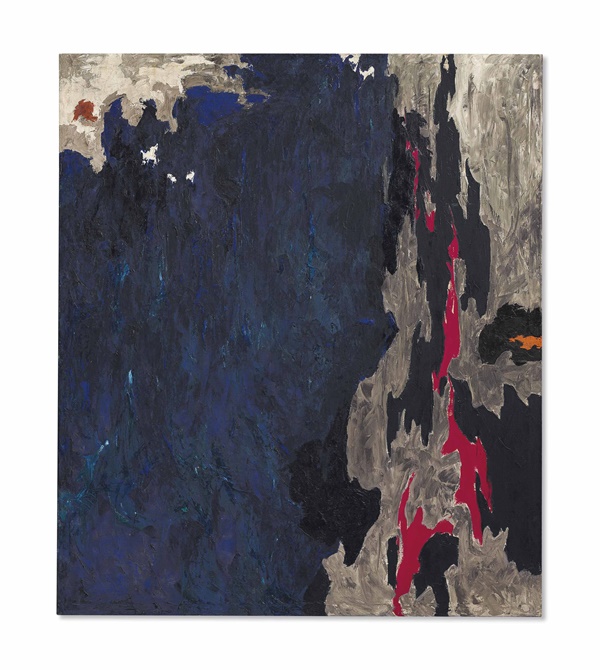
Clyfford Still, PH-234 (1948). Courtesy of Christie’s Images Ltd.
Another artist with a strong following is Clyfford Still, whose strict rules about the use and display of his artwork during his lifetime and beyond has made for a tightly controlled sale and exhibition history. For these reasons, the artist’s paintings are a rare sight at auction. PH-234 (1948) carried an estimate of $25 to $35 million.
Given this fact, bidding seemed surprisingly thin. After a few bids, it was hammered down to Christie’s Laura Paulson on behalf of a phone bidder. With premium, the final price was $28.2 million.
It was encouraging to see artists Agnes Martin and Joan Mitchell in the ten highest lots of the sale. A new auction record was set for Martin when Orange Grove (1965), sold for a record $10.7 million, well surpassing the previous auction high of $6.5 million set for The Beach (1964), at Sotheby’s in 2013.
Bidding was also healthy for Mitchell’s Noon, (1969), which garnered a final price of $9.8 million on an estimate of $5 to $7 million. While it was shy of Christie’s 2014 record of $11.9 million, set for an untitled 1960 canvas, it is nonetheless an encouraging vote of market confidence in Mitchell’s work.
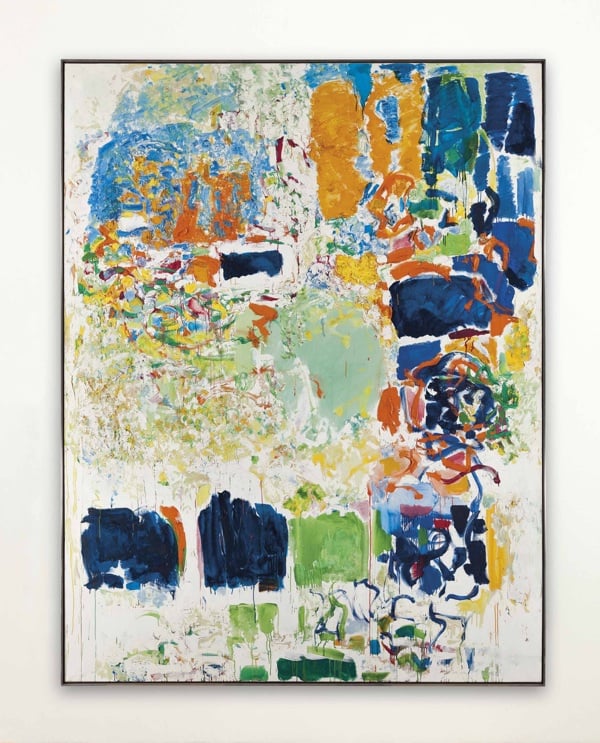
Joan Mitchell Noon (1969). Image: Courtesy of Christie’s Images Ltd.
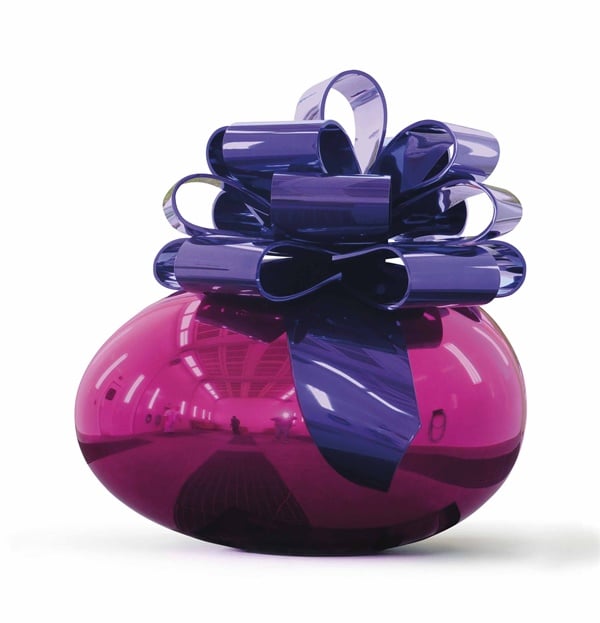
Jeff Koons, Smooth Egg with Bow (Magenta/Violet) (executed in 1994–2009). Courtesy of Christie’s Images Ltd.
Of course, what would an evening contemporary sale be without a giant shiny Koons bauble on offer? Smooth Egg with Bow (Magenta/Violet) (executed in 1994–2009) was estimated at $7-10 million, and sold for a hammer price of $6 million, or $7.4 million with premium. After its initial fabrication, the work was acquired from Gagosian, though the provenance does not specify when.
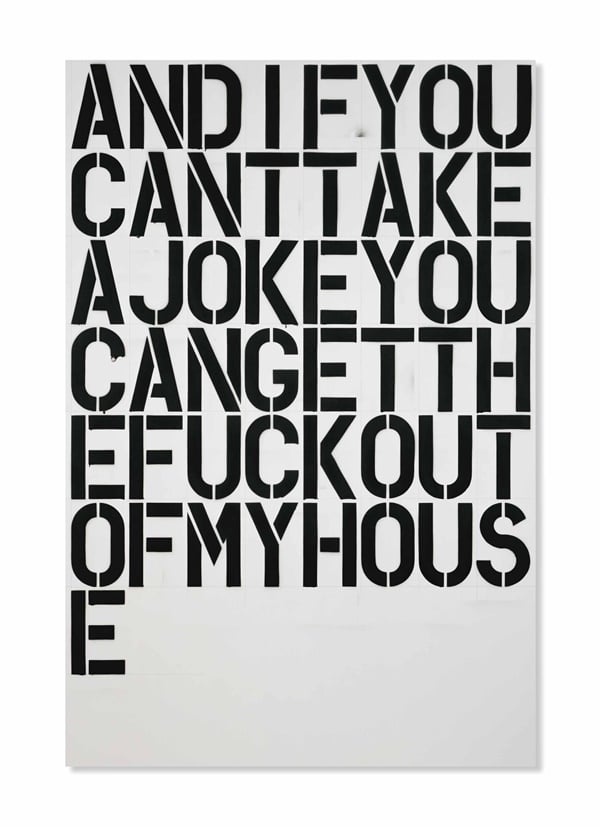
Christopher Wool, And If You (1992). Courtesy of Christie’s Images Ltd.
It was also the first time at auction for Christopher Wool’s irreverent word painting And If You (1992), which is incidentally one of our hands-down favorites of the night.
With text that reads in Wool’s run-on style “And if you can’t take a joke you can get the fuck out of my house,” we noted how Pylkkanen, in announcing the lot, opted for the “abbreviated” title rather than repeat the full sentiment to the well-heeled crowd at Christie’s.
Bidding was short and sweet. It sold for $13.6 million ($12 million hammer), with an estimate of $12 to $18 million. Gorvy acquired it on behalf of a phone bidder.
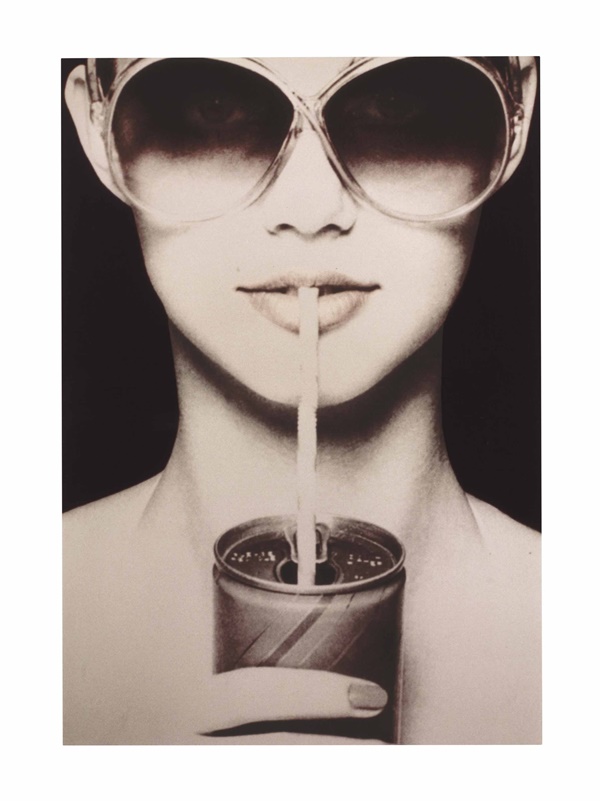
Richard Prince, Untitled (Fashion)(1982). Christie’s Images Ltd.
It was a good night for Richard Prince as well. An early work, Untitled (Fashion) (1982) sold for $2.8 million on an estimate of $1.5 to $2 million. And Runaway Nurse (2005-6), from the artist’s popular “Nurse” series, sold for $9.6 million on an estimate of $7 to $10 million.
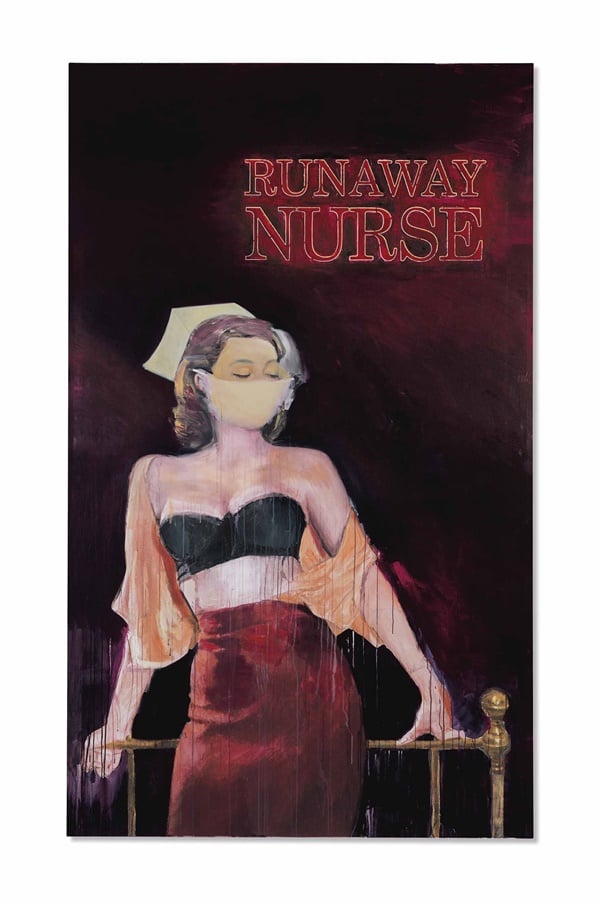
Richard Prince, Runaway Nurse (2005-6). Courtesy of Christie’s Images Ltd.
Another big Koons bauble, the artist’s giant stainless steel Lobster, sold for $6.9 million. It was won by Inoue and the paddle number indicated it was the same buyer who dropped a hefty sum on the record-breaking Basquiat.
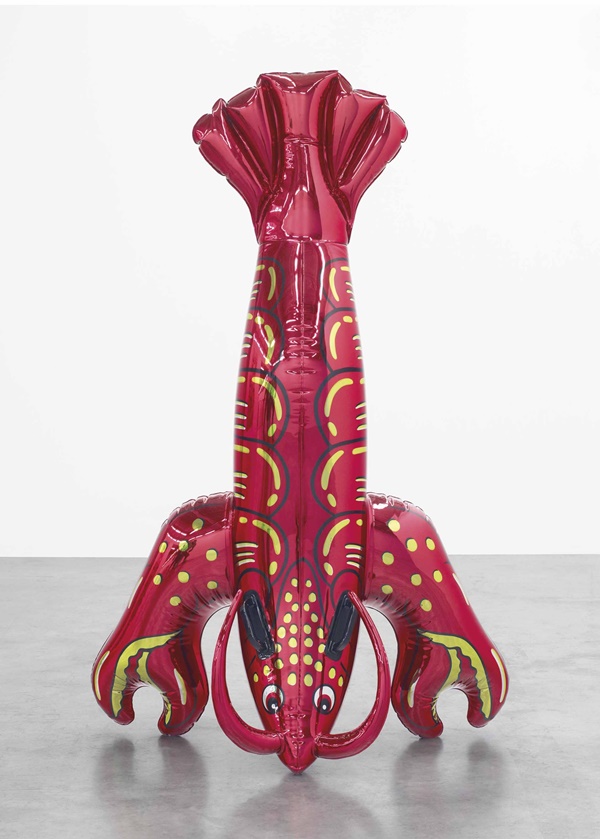
Jeff Koons, Lobster (executed in 2007-2012). Christie’s Images Ltd.